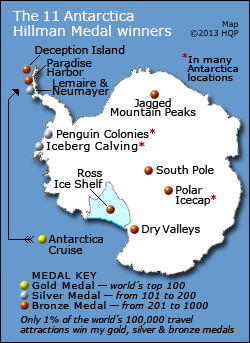Dry Valleys
 Why the
Dry Valleys
of Antarctica
are special
Why the
Dry Valleys
of Antarctica
are specialThey are one of the driest places on earth. Rainfall has been extremely rare during the past two million years.
Dry Valleys tips and& insights
NASA
When NASA noticed a similarity between the ultra dry landscapes of Mars and the Dry Valleys, it decided to conduct research in these desolate Antarctica valleys in preparation for its Viking missions to Mars.
Iceland ground
This 4,000 square kilometer (1600 square mile) area is one of the few Antarctica places not covered with ice. The two main reasons:
- Dry atmosphere
One reason is the atmosphere is so dry that it rarely snows. When it does, the snowfall is sparse and evaporates quickly. - Mountains
The second and most important reason is that mountains block the path of glaciers that would otherwise pass over the Dry Valleys. What glacial ice reaches the valleys is skimpy and evaporates within several weeks. If it were not for the mountain barrier, the Dry Valleys would be buried under the ice cap, as is most of Antarctica.
They are separated by iceless mountain ridges. Their names are Taylor, Victoria and Wright.
Rock-strewn ground
The valley floors are scattered with small and large rocks. Some of the rocks have been shaped over time into grotesque forms by the valley's strong winds.
Life
The land is not entirely lifeless. Some small scale life (including fungi) have evolved into life forms that live inside the porous rocks.
Location in Antarctica

The Dry Valleys are near the Ross Ice Shelf, and even closer to the US operated McMurdo Station. The latter is known for its ecological and environmental research.


